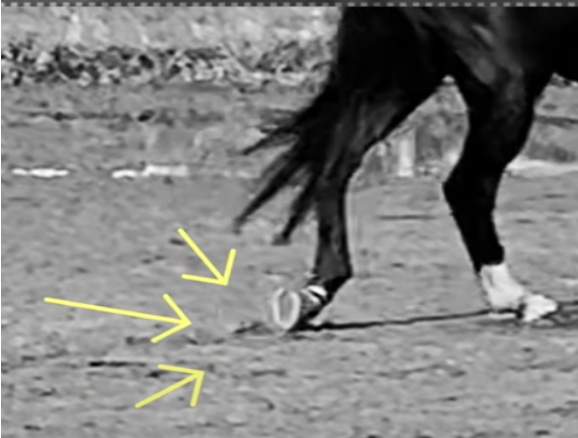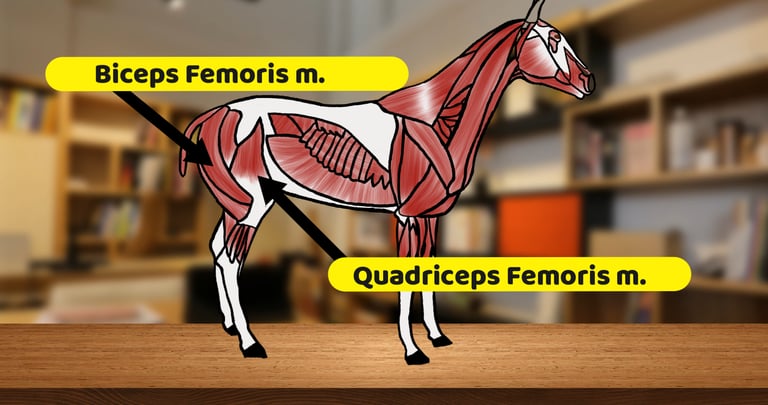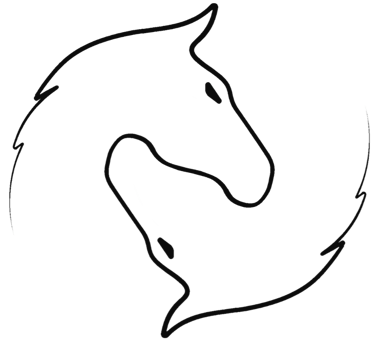Dragging of the Hind Hoof Tip in Horses
PROFESIONAL EDUCATIONAL ARTICLES
Dragging the tip of the hind hoof, sometimes even on both legs, is observed in horses at all levels of training and even in those that are not ridden. It is always important to realize that dragging the hoof tip has a physiological cause. Whether it is due to a congenital unsuitable body structure or an acquired health problem, it is necessary to consider the horse’s usability and the impact of hoof tip dragging on its performance.
Horses that drag the tips of their hind hooves usually suffer from associated riding problems, which outwardly resemble those of horses with back pain, such as in kissing spines. Moreover, hoof tip dragging is very often related to kissing spines.
The first aspect that has a fundamental influence on dragging the hind hoof tips is congenital anatomical predisposition. Horses with a steeper hind limb posture, and therefore a weaker Quadriceps Femoris m. and Biceps Femoris m., tend to encounter this problem more frequently. Typically, this issue occurs in horses that are "long" in the lumbar region and have a short, flat pelvis. They often also have close-set hocks and outwardly rotated hoof tips.


In such cases, if a horse has a predisposition to dragging hoof tips, we must focus on its working tempo during training to minimize the dragging. The workload must be adjusted, and an appropriate riding discipline should be chosen that considers its physical limitations. These horses often experience riding problems in dressage and jumping work in the arena, but in nature, they can be quite comfortable recreational horses.
One of the main indicators of knee problems is difficulties with canter and the horse’s reluctance to move after about twenty minutes of standard work in the arena. There is little we can do as riders about congenital body structure, but we can adjust our approach and work with the horse in a way that eliminates its handicap and prevents any difficulties for both the horse and the rider.
The second most common trigger for hoof tip dragging is injuries that cause compensatory movement in the horse, leading to weakened function of the Biceps Femoris m. and Quadriceps Femoris m.. In these cases, it is crucial to eliminate the primary source of the problem within the horse's body, which affects the function of the muscles necessary for proper movement of the hind limbs. Specific exercises should be used to strengthen the Quadriceps Femoris m. while maintaining flexibility, stretching, and contraction of the Biceps Femoris m..
As I wrote in my article: How the Horse's Knee Works - The Key to Movement and Performance (Part I), the knee and hock function as a single unit. If a horse has problems in the hock that affect its ability to bend and extend properly, the function of the knee is also restricted. This has a direct impact on knee function and can lead to a permanent so-called “locking” of the knee, where the limb does not flex properly through the correct engagement of flexors and extensors. This results in dragging or even just lightly tapping the hind hoof tip on the ground.
In such cases, the problem manifests as a reluctance to perform lateral movements and difficulties with cantering, usually on one lead. The horse may tend to travel in counter-canter or refuse to canter entirely on the more affected limb.
If you experience issues with canter transitions in the arena, notice your horse being lazier, or find that after around twenty minutes of standard arena work it becomes less willing to cooperate, it likely has issues with full hock functionality. Many times, veterinary examinations do not reveal anything abnormal in the hock because the issue may stem from unsuitable body conformation or other associated difficulties that restrict full hock function—including improper hoof care (shoeing with iron or metal horseshoes). Horses that are trimmed rather than shod tend to avoid these issues, as the flexibility of an unshod hoof compensates for many anatomical disadvantages, reduces stress on the hocks and knees, and prevents their overloading.
One solution that significantly helps in cases of hoof tip dragging is stopping the use of iron or metal horseshoes and exploring other options, such as trimming in combination with hoof boots for work on hard surfaces or using soft plastic horseshoes.
In conclusion, if horses—whether they have congenital body structure issues or acquired injuries—receive sufficient attention when experiencing problems such as dragging their hind hoof tips, this condition can be minimized and, in some cases, even eliminated. However, if the issue is addressed solely by forcing the horse into increased activity to compensate for the dragging, the condition will eventually worsen, leading to more severe riding problems that require costly and time-consuming solutions.
Therefore, pay attention to your horses, and if they have a predisposition to this problem, adjust their care and riding style accordingly. This way, these horses can remain reliable and willing partners well into old age, even under sport-related workloads.


